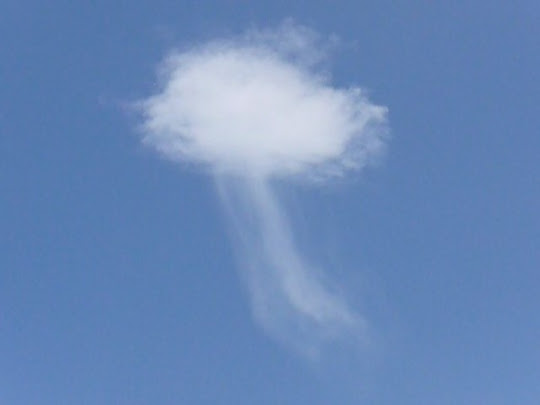Spotting shapes in clouds is a delightful way to pass a lazy afternoon. There's even a society dedicated to cloud spotting. It’s called the Cloud Appreciation Society, founded by Gavin Pretor-Pinney to foster understanding and appreciation of clouds, and to fight “blue sky thinking”.
A clear blue sky has always been associated with good, happy weather – a perfect summer’s day, while cloudy skies are regarded as a metaphor for doom. Nothing could be more depressing, it seems, than to have ‘a cloud on the horizon’. Gavin Pretor-Pinney decided that this has to stop. “Someone needs to stand up for the clouds”, he says. So in 2004, he started the Cloud Appreciation Society and few months later launched a website. People sent in their cloud photograph, which he put up on the gallery pages for others to look at. The early trickle of submission soon swelled to a torrent. Today, it has over 29,000 members worldwide from 83+ different countries, and many thousands of amazing images.
Below is a collection of some of the most peculiar cloud formations.


A cloud monkeying around over Bangkok.

Cloud Alien ahead.....Eagle River Valley, Colorado. U.S.

Aladdin's lamp, spotted over The Torres del Paine National Park, Chile.

A baby floats over Zurich, Switzerland. Photo by Danièle Siebenhaar.

The big chicken on the roof of Manor Market in Bishop California, is being mirrored in the clouds.


A dolphin leaping from an inky black sea over Sussex, UK.

Dolphins at play, Sausalito, California. U.S..

A heart in the clouds over Norwich, UK.

A Dove over Kent, UK.

Eagle soars over Cambridge. U.K.

Elephant in a storm cloud, taken on holiday at Patong Beach, Phuket, Thailand.

A feather over Brockenhurst in the New Forest, Hants., UK.

A heart over SuperDevoluy, Saint Etienne en Devoluy, France.

A hummingbird over Berryton, Kansas, US.

Jack Palance, spotted over Loudonville, Ohio, US.

A jellyfish over Berry, New South Wales, Australia.

A cumulus called Kitty, Western New York. U.S.

A man running with a bouquet of flowers. Spotted over France.

A giant Mushroom over North Jutland, Denmark.

Poodle spotted over Sanderstead, Surrey. U.K.

A poodle with shades enjoys a day by the sea over Blackpool, Lancashire, UK.

A rabbit hopping over Nottinghamshire, UK.

Shhhhhh dont tell anyone. There's a monster rat over Tortona, Alessandria,

A sunset smile over West Hollywood, California, US.

Little Cumulus cloud from East Texas, US, smoking.

A snail, spotted just before sunrise over Anglesey, UK.

A turtle travelling on the back of a crocodile over the border between France and Spain.

A witch or the grumpy old man in the muppets over Bangkok.

The iconic scene from TV programme The Apprentice, when Lord Sugar says "you're fired", acted out over Bangkok.
Source
READ MORE»
A clear blue sky has always been associated with good, happy weather – a perfect summer’s day, while cloudy skies are regarded as a metaphor for doom. Nothing could be more depressing, it seems, than to have ‘a cloud on the horizon’. Gavin Pretor-Pinney decided that this has to stop. “Someone needs to stand up for the clouds”, he says. So in 2004, he started the Cloud Appreciation Society and few months later launched a website. People sent in their cloud photograph, which he put up on the gallery pages for others to look at. The early trickle of submission soon swelled to a torrent. Today, it has over 29,000 members worldwide from 83+ different countries, and many thousands of amazing images.
Below is a collection of some of the most peculiar cloud formations.


A cloud monkeying around over Bangkok.

Cloud Alien ahead.....Eagle River Valley, Colorado. U.S.

Aladdin's lamp, spotted over The Torres del Paine National Park, Chile.

A baby floats over Zurich, Switzerland. Photo by Danièle Siebenhaar.

The big chicken on the roof of Manor Market in Bishop California, is being mirrored in the clouds.


A dolphin leaping from an inky black sea over Sussex, UK.

Dolphins at play, Sausalito, California. U.S..

A heart in the clouds over Norwich, UK.

A Dove over Kent, UK.

Eagle soars over Cambridge. U.K.

Elephant in a storm cloud, taken on holiday at Patong Beach, Phuket, Thailand.

A feather over Brockenhurst in the New Forest, Hants., UK.

A heart over SuperDevoluy, Saint Etienne en Devoluy, France.

A hummingbird over Berryton, Kansas, US.

Jack Palance, spotted over Loudonville, Ohio, US.

A jellyfish over Berry, New South Wales, Australia.

A cumulus called Kitty, Western New York. U.S.

A man running with a bouquet of flowers. Spotted over France.

A giant Mushroom over North Jutland, Denmark.

Poodle spotted over Sanderstead, Surrey. U.K.

A poodle with shades enjoys a day by the sea over Blackpool, Lancashire, UK.

A rabbit hopping over Nottinghamshire, UK.

Shhhhhh dont tell anyone. There's a monster rat over Tortona, Alessandria,

A sunset smile over West Hollywood, California, US.

Little Cumulus cloud from East Texas, US, smoking.

A snail, spotted just before sunrise over Anglesey, UK.

A turtle travelling on the back of a crocodile over the border between France and Spain.

A witch or the grumpy old man in the muppets over Bangkok.

The iconic scene from TV programme The Apprentice, when Lord Sugar says "you're fired", acted out over Bangkok.
Source

























